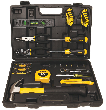Organizing receipts is an important tool not only for understanding office finances, but for all financial work in general. After all, what better way is there to know where your money is going to? However, if you don't take the time to actually sit down and organize your receipts, then you will have a huge mess both financially and physically. In order to get the best possible effect from your receipts, you should begin organizing receipts in two distinct ways. The first way is by instituting a physical paper system; the second is by using an electronic system. These two systems are detailed here.
Paper system.
Begin organizing your receipts by instituting a hanging file system. Get three hanging folders, and label them Current Month, Last Month, and Archives. In side each of these large folders, place a few smaller ones that you can label according to category. For example, you can have subjects for Food, Gas, Housing, Entertainment, and so on. When you get home, place each receipt into their appropriate file. When you enter the data from the receipts into your electronic system, place a small checkmark on it so you do not get confused.
At least once a month, usually when you begin planning the next month's budget, enter the data from the receipts into your electronic system. Once you have balanced your check book, as well as planned out the next month's budget, simply move your Current Month folder to the :Last Month location, and then the previous Last Month folder can be placed into archives. Hold onto the Archives folders and use them to help you with your taxes. If you have any questions about any expenses, this way you can refer to the physical receipt and get some clarification.
Electronic system.
Computer programs such as Excel and Quicken are wonderful things to use for an electronic receipt organizing system. Typically, you will want to set your electronic system up in way that you can keep track of your expenses and receipts. For example, you should separate your expenses into three sections, and also create another section for your income. The three expense sections should be set up with the headings of Fixed, Variable, and Semi-variable.
In the three sections you should enter the information that is pertinent to each category. For example, you could enter mortgage payments and car payments into the Fixed section; food and gas costs will go into the Variable section; items such as phone bills, and electricity bills, which can change from month to month (though usually not much) will go into the Semi-variable section. Doing this will allow you to quickly and easily determine what the average amount you pay each month is, and work out a fast budget. Compare these figures to what you input into your income folder, and you will have no problem figuring out where you stand financially.

Find the Right Tool Right Away Finally, a homeowner's set that includes all the tools needed to complete basic DIY projects at an affordable price! The tools are stored in a molded case for security and portability. Check out Stanley 65-Piece Homeowner's Tool Kit today!
In today's fast- paced society, the need to keep your important bills organized so they are paid on time is crucial. ...
Discover MoreFiling services can help provide a much needs service for just about any type of business. These services can come in and ...
Discover MoreBills can be a major pain, particularly when you don't have a whole lot of money to go around. However, by taking some ...
Discover MoreThere are currently no comments for this tip. (Be the first to leave your comment—just use the simple form above!)
Copyright © 2025 Sharon Parq Associates, Inc.
Comments